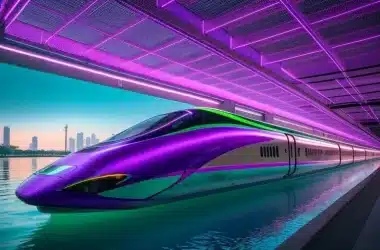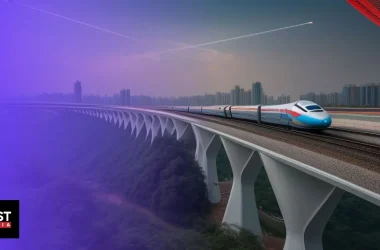2024 is shaping up to be the year of massive megaprojects with so many wrapping up all around the world. But out of all these megaprojects, there are five that will truly transform their countries’ landscape thanks to their sheer size and ingenuity. We’ve ranked these multi-billion-dollar megaprojects according to cost and while a few of them will set new records, they all will have a massive impact on their countries’ economies for years to come.
Woven City – Japan

Japan’s Woven City is an impressive megaproject for a number of reasons. This sustainable smart city is Toyota’s attempt to become a global leader in smart city technology which might come as a surprise since the automaker isn’t really though of as the type of company to undertake a megaproject like this one.
However, the name Woven City highlights how the project plans to weave together cars, robots, data, and computers to create a highly efficient and pollution-free city. This hub of sustainability, technology, community, and mobility was designed by Danish architect Bjarjk Ingels, who has designed impressive projects like the Vancouver House skyscraper in Canada and the Omniturm skyscraper in Germany.
Construction on this “prototype city of the future” started in 2021 on a 175-acre site near the base of Mt. Fuji, only 60 miles away from the capital of Tokyo. It is meant to act like a “living laboratory” with thousands of residents to test and develop new technologies such as autonomous vehicles, robotics, personal mobility, smart homes, and AI in a real-world environment.
The city perfectly combines new technology and green and sustainable construction. It will run completely on hydrogen fuel cell energy technology and solar power, and its homes will be made from wood to reduce its carbon footprint. The city layout is also designed to include neighborhoods, parks, and a central plaza with recreational and social gathering spaces.
Goods will be delivered by autonomous electric shuttles, and residents in Woven City can monitor their health using AI-powered sensors while robots assist people daily. Clearly everything in this city is planned down to the finest detail, including the food residents eat which will be based on molecular science for residents’ health.
Toyota’s autonomous vehicle ambitions played a central role in the city’s design since Woven City’s main feature is the three different roads acting as a test track for smart mobility. One road is strictly for AI-powered autonomous vehicles, with a green road dedicated for cyclists, and a third for pedestrians.
When this $1 billion megaproject is completed in the summer of 2024, Toyota will send about 360 people to live in the futuristic city to test it out. As time progresses, the population will grow to more than 2,000 people, allowing the city to become a human-centered laboratory for scientists, engineers, and researchers to test the latest technologies in real urban environments.
If Woven City succeeds, then it will serve as a catalyst for more fully automated smart cities embarking on a sustainable, green route in the future.
Iconic Tower – Egypt
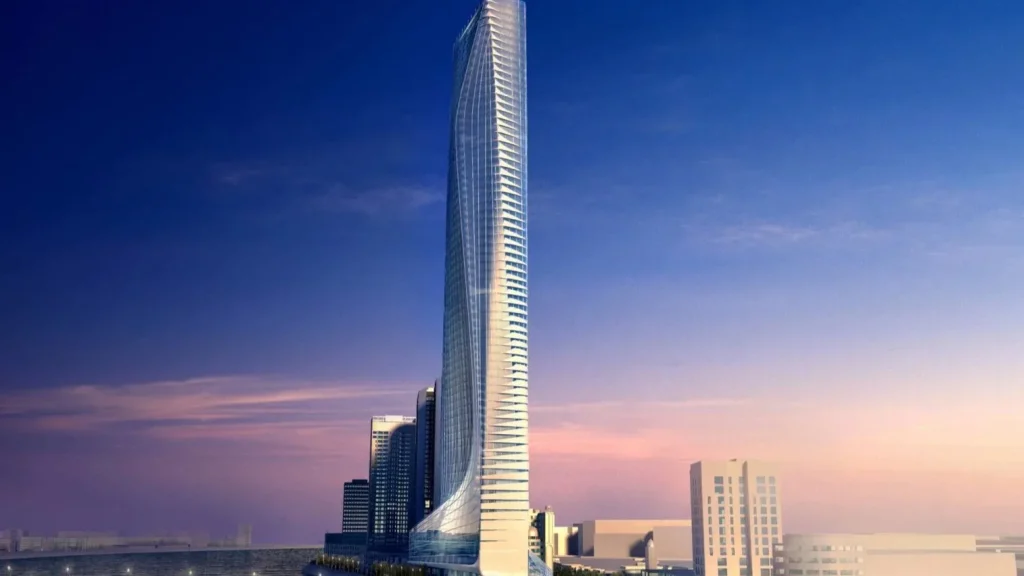
This new tower, rising from the desert 45 kilometers away from Egypt’s capital of Cairo, will make Egypt home to Africa’s tallest building at 394 meters tall.
In comparison, the Cairo Tower, formerly the tallest building in Egypt and North Africa, is only 187 meters tall. Once its completed, the Iconic Tower will overtake the Leonardo, a 55-floor, mixed-use property development in Johannesburg, South Africa, which stands at 234 meters tall.
The Iconic Tower will be the centerpiece among 20 other towers in the Central Business District in the New Administrative Capital, a $58 billion megaproject launched by the Egyptian government in 2015. Construction on the tower began in 2019 with support from the China State Construction Engineering Corporation as part of Xi Jinping’s Belt and Road Initiative.
The impressive tower was designed by Dar Al-Handasah, an architectural firm founded in Beirut in 1956 with a principal design center in Cairo. Taking inspiration from the shape of a pharaonic obelisk, the tower was also designed with a glittering glass exterior to represent the Egyptian god Amun’s Shuti crown.
Aside from paying homage to Egypt’s ancient history, the tower’s façade is similar to the country’s national flower – the Egyptian lotus flower – which represents rebirth and creation. Architecturally, the tower has other iconic features such as its air vents which rotate according to the angle of the sun to lower the temperature throughout the day.
Built on more than 241,000 square meters, the Iconic Tower will have 80-stories and two basement levels. The first 40 floors of the tower are designated for offices, followed by 10 floors of apartments, and 30 floors which may be included as part of a 5-star hotel. The 74th floor will feature an observation deck to give visitors an aerial view of the New Administrative Capital.
But the Iconic Tower comes with an equally impressive price tag of $3 billion. Once completed, it will become Egypt’s newest landmark in the desert serving as both a tourist and investment attraction in Egypt’s new capital.
Noida International Airport – India
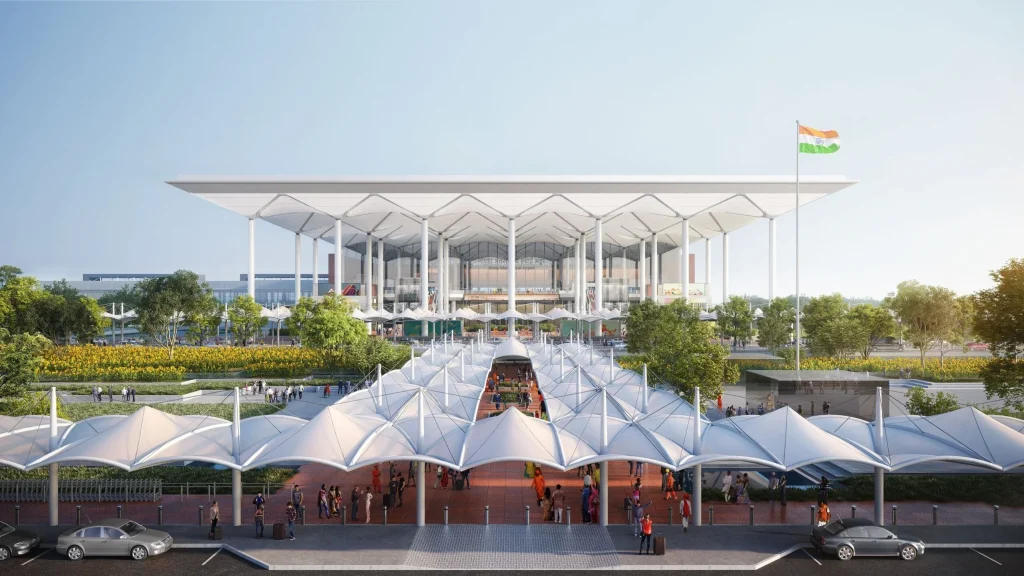
India’s Noida International Airport, also known as Jewar Airport, is an impressive megaproject as well. The airport will be built near Jewar in the new planned YEIDA city and is being developed by a subsidiary of Zurich Airport International AG.
The airport’s CEO, Christoph Schnellmann, said the airport will use all the digital technologies available and operate sustainably by minimizing carbon dioxide and other emissions.
Spread across 1,334 hectares, this greenfield airport project will initially start with two runways in its first phase – giving it the capacity to handle 12 million passengers annually. Additional expansion plans will bring that number to 60 million passengers to dramatically improve connectivity between Noida, Western Uttar Pradesh, Delhi, and NCR.
Eventually, the airport will link to the planned Delhi-Varanasi High-Speed Rail, shortening the journey between Delhi and the airport to just 21 minutes. The site is already strategically connected to Noida, Greater Noida, and Delhi via pod taxi, monorail, and rapid rail.
Thanks to this accessibility and its location just 75 kilometers away from Delhi, it’s expected to be an alternative to Delhi’s Indira Gandhi International Airport. Once completed, it will help relieve the already high and rising traffic load overwhelming Delhi’s airport.
To ensure maximum efficiency, office spaces for all airport workers are included on the premises with plans to provide residential accommodation and parking for government agencies as well.
As is, $3.55 billion has been invested in the airport but the hope is that this investment will pay off thanks to the boost to tourism and the economy this connectivity brings. Better connections to global supply chains will also improve regional industrialization and open up new business opportunities for the region.
Clearly, Jewar Airport is a big deal for India, especially since the airport’s foundation stone was personally laid out by Prime Minister Narendra Modi in 2021. Construction started just a year later and more than half of the project was completed as of August 2023. Thanks to this progress, authorities are confident construction will be completed before its deadline of December 2024.
Once completed, Jewar Airport will be the largest airport in both India and Asia. And as of November 2023, it had already signed an agreement with IndiGo airlines, India’s largest domestic airline, securing its place as the first airline to offer flights from Jewar Airport.
Gordie Howe International Bridge – US & Canada

Out of all the megaprojects on this list, the Gordie Howe International Bridge could be the most impressive in terms of both its aesthetics and its practicality. A joint effort between the United States and Canada, this cable-stayed international bridge spans the Detroit River connecting Detroit, Michigan with Windsor, Ontario.
This $5.7 billion megaproject is named after the Canadian ice hockey player Gordie Howe, who had a celebrated 25 year career with the Detroit Red Wings. Not just a symbol of the two countries’ shared love of hockey, the Gordie Howe bridge will also boost the economies of both cities by facilitating the orderly flow of people and trade.
Construction started in 2018 and at a length of 2.5 kilometers it’s expected to be the longest cable-stayed bridge in North America. However, once its completed by the end of 2024 it will only rank 10th longest in the world.
The bridge will have two A-shaped towers and six lanes for automotive traffic as well as a 12 foot wide bicycle and walking path. The two towers were completed this year after beginning construction in 2019. Each tower stands 722 feet tall and will support the weight of the bridge through cables attached to the road deck.
The bridge includes a number of features like energy-efficient LED and low-maintenance lighting. After completion the bridge may feature some light shows since the construction team stated it will work with an artist to develop this feature.
To integrate the bridge with the nature surrounding it, peregrine falcon boxes are included to facilitate nesting. But throughout the construction itself, builders were careful to limit the damage to the surrounding areas. New buildings were designed with green roofs and native plants were relocated or replanted to maintain the ecosystem.
While the bridge is an impressive architectural megaproject, it serves a very practical purpose as well. Every single day, $2 billion in goods and services cross the Canada-U.S. border.
To facilitate this cross country exchange, new ports of entry connecting both the American and Canadian bridge terminals will be built as well. The new Canadian Port of Entry will be built on a 130 acre site making it the largest Canadian port on the U.S.-Canada border. Not to be outdone, the American Port of Entry will be developed on a 167 acre site making it one of the largest border facilities in North America.
Tren Maya Railway – Mexico
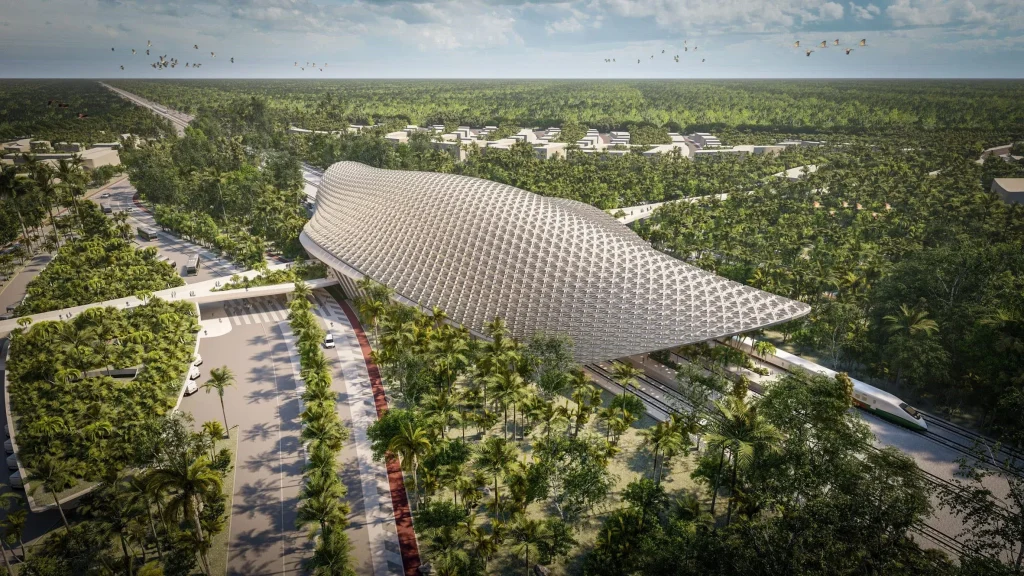
With a price of $10 billion, out of this list of megaprojects, Mexico’s Tren Maya railway is definitely the most expensive. This brand new train route will likely be ready for passengers some time in early 2024 and could boost tourism thanks to its amazing views.
Blending history, culture, and nature together along its 1,500 kilometers of track, this train route will offer a beautiful glimpse of southern Mexico’s dense jungle and its Caribbean Coast.
When completed, the Tren Maya railway will carry passengers through 29 stations around the five most southern Mexican states of Chiapas, Tabasco, Campeche, Yucatán and Quintana Róo, linking major tourist sites and cities such as Chichén Itzá, Cancun, Bacalar, Mérida and Palenque.
The high-speed train will be capable of traveling at a maximum speed of 160 kilometers per hour, reducing travel time between popular destinations. For example, the journey from Cancun, a city in southeast Mexico, to Mérida, the capital of the Mexican state of Yucatán, will take just 90 minutes rather than four hours by road.
But, it’s not just a railway project. In fact, it will also include six luxury hotels and two ecological parks. Each hotel will be located near archaeological sites to facilitate easy access and offer designated biking areas.
This megaproject was launched by the Mexican government as part of the national development plan for 2019 to 2024. Bombardier, a Canadian company and a global leader in the business aviation industry, will oversee the production of 42 trains for the project.
Producing the safest and most efficient train cars will be a significant undertaking for the company since the railway network is expected to transport over 10,000 passengers every day, not including cargo.
Like many other megaprojects, this one aims to boost the country’s tourism sector and is expected to attract three million tourists annually. For Mexico, this is especially important because tourism is a vital part of its economy, contributing more than 8% to the country’s GDP over the past decade and employing up to 4.4 million people today.
Overall, Tren Maya offers employment opportunities, enhanced infrastructure in the southeast of Mexico, increased investment in the region, and could attract new companies. Thanks to these improvements to Mexico’s transportation and economic growth, the government anticipates more than 33 billion pesos, or $1.9 million in productivity when it opens.
However, like many other megaprojects, Tren Maya was not without controversies. It faced criticism for harming the environment with construction leading to the destruction of nearly 9 million trees and 120 square kilometers of jungle so far.
Conclusion
Megaprojects like these can be a huge benefit for their countries, however it is not a guarantee of success. Some megaprojects do fail, and when they do its a mega failure.
With all of these projects coming to completion in 2024, there is a lot to look forward to whether its boosting tourism, industrialization, trade, or connectivity. Given the significant investment made in each project, it will be a number of years before their initial investment is made back. Still, megaprojects usually create short term if temporary benefits through employment. For now, each country will have to wait patiently to see the long-term benefits of their megaprojects come to fruition.
Disclaimer
Please visit and read our disclaimer here.






